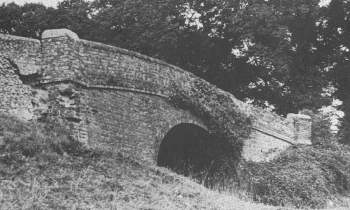 |
 |
 |
 |
 |
 |
 |
 |
 |
 |
 |
 |

Portsmouth & Arundel Canal
In
1815 a group of promoters who were considering providing a canal from
the River Arun to Portsmouth, approached the Admiralty for approval.
The Admiralty consulted Charles Rennie, who was in favour of the
project and when asked for advice by the promoters, employed Francis
and Netlam Giles to conduct a survey. Rennie then recommended a barge
canal, 33ft wide and 4ft 6in deep, 12 miles long from the tidal Arun
at Ford, to Salterns near Birdham, in Chichester Harbour, with four
locks (two at either end) and a 11/4 mile branch from Hunston to
Chichester. The route from Salterns was via Thorney Channel, Langstone
Channel and Langstone Harbour to enter the Portsea Canal at Milton.
The Portsea Canal was 2.5 miles long, with two locks at Milton, and
ran across Portsea Island, to a basin at Halfway Houses, Ports mouth.
There was also to be a 1.25 mile cut across the top of Portsea Island,
via Cosham, giving access to Portsmouth Harbour.
The
promoters obtained their Portsmouth and Arundel Canal Act in 1817, but
the first sod was not cut until 20 August 1818 at Ford. Work also
began at Merston on the Chichester section in September, and must have
been considered of more importance, as the Ford-Hunston section was
opened last.
Chichester
Canal basin was filled with water on 27 December 1821, and the
Chichester Canal opened on 9 April 1822. Next came the Portsea Canal
on 19 September 1822 and finally the 9.5 mile Ford to Hunston Section was
opened on 26 May 1823. The company had two pumping stations, at Milton
top lock and at Ford top lock, to provide water to the two summit
levels. Unfortunately, they had problems with salt water entering the
canal and percolating into local water supplies. The problem at Milton
was so serious that in the end the company was forced to drain the
Portsea canal.
|
|
|
|
 |
 |
 |
 |
 |
 |
 |
 |
 |
 |
 |


Ford canal Bridge at the entrance to
the Portsmouth and Arundel Canal. It was demolished in 1930.
In
1830 the Portsea Canal was formally closed, although of course it
had not been used for some time (it had been drained for at least
3 years), and the company opened their new Portsbridge Cut which
gave direct access, across the top of Portsea Island, into
Portsmouth Harbour. Efforts were made to increase the level of the
London-Portsmouth trade, but with little success. However, some
bullion was moved from Portsmouth by canal, and for a few years in
the early 1830s, the level of general goods improved. However, the
Portsmouth and Arundel Canal only continued due to support from
the Chichester section, and the company’s finances were on the
brink
As a result of railway competition, the Ford-Hunston section of
the canal ceased to be used after 1847. Traffic on the remaining
section of the canal, from Salterns Lock to Southgate Basin,
Chichester had fallen to about 4,000 tons in the 1880s and in 1888
a group of shareholders applied for an order to wind up the
company. The order was granted and following an Act of Parliament
in 1892, the Chichester Canal was transferred to Chichester
Corporation. Trade gradually dwindled even more, and the last
commercial traffic used the canal in 1906. In 1928, the canal was
finally abandoned, but the section from Salterns Lock to Manhood
End was re-opened in 1932 for yacht moorings. In 1957 the canal
was sold to West Sussex County Council for £7,500.
A more detailed history of the Chichester Section is given in the Chichester
Canal
Find
out more information on canals in the Sussex Bookshop...
Return
to the Sussex Waterways Home...
Return to the Sussex Main
Page...
|
|
|

